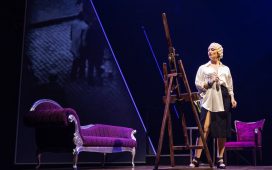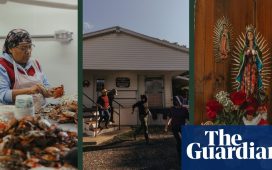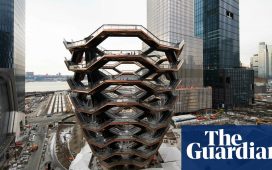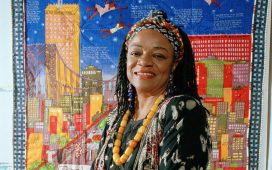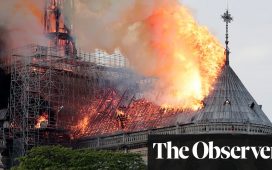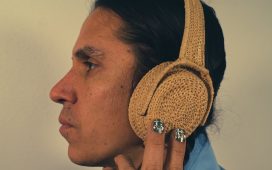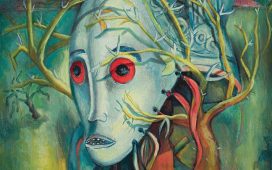Grace Robertson, who has died aged 90 of a stroke, made her reputation in the 1950s as a freelance photojournalist on the weekly editorial magazine Picture Post.
One story, titled Mother’s Day Off, has become her signature. Early in her career, in 1954, she accompanied a group of Battersea “charladies” on their annual charabanc excursion to Margate in Kent. She accompanied them too, as she proudly recalled when she and I last met, in 2015, pint for pint (beer and cockles) and joke for joke, as she recorded their “exuberance”. An iconic image of the women having a laugh and a singalong – one seated on the lap of another, wearing outsized pantaloons over her skirt – was, according to Matthew Butson, director of the Getty Images Picture Post archive, “her most popular story … certainly the one she’ll be best remembered for”.
In her autobiography Grace Robertson: Photojournalist of the 50s (published by Virago in 1989) Robertson commented on how the women’s homes “lay in the terraces clustered about their local pub, centre of most local activities; their children, grandchildren, aunts and uncles lived in the surrounding streets … Soon new housing estates and high-rise flats would break into this extended family network, with its unique spirit of comradeship and circle of supportive friends.”
Despite the fact that her approach chimed with Picture Post’s celebration of working-class culture and of the welfare state, the magazine initially refused to accept Robertson’s proposals for what were seen as “women’s subjects”. Her idea for Mother’s Day Off was originally rejected, and she had to shoot the outing without a commission. The following year she made an explicit feature on a hospital birth, titled The Pain of Childbirth. It was killed “on the grounds it might upset female readers”.

Small wonder she had begun by submitting work under the pseudonym Dick Muir (using her mother’s birth name). Even smaller wonder it was returned with a note: “Persevere young man.” It was her quiet determination, as well as her professionalism, that made her a popular and respected member of the Picture Post team. In common with other female photographers, however, she did not become a staffer, and said she came to prefer the independence of remaining freelance.
Robertson’s work has been so extensively re-evaluated and contextualised by second-generation feminists that it is easy to overlook her courageous insistence when confronted by stubborn prejudice.
She was born in Manchester, the daughter of Betty (nee Muir) and Fyfe Robertson. Her father was a crusading Scottish journalist, who from 1943 worked on Picture Post as a writer and picture editor. By then the family had moved south to live in Surrey. By 1946 Grace’s mother had become seriously ill with rheumatoid arthritis, and Grace left school at 16 to help at home, persuading her father to treat her to a second-hand Leica.
In 1949 she went to London to consult Simon Guttmann, seen as one of the founders of photojournalism, about offering work for publication to his photo-agency, Report. Unfortunately, he took exception to some of her images, whose composition he compared unfavourably with the work of the Picture Post photographer Kurt Hutton, flinging them on the floor before stamping on them.

So Picture Post it was for her, despite her initial reluctance given that her father worked there, and she regularly contributed to the magazine until its closure in 1957. By then she was supplying a number of other magazines, from the Illustrated London News to American Life.
In 1955 she had married a fellow photographer, Thurston Hopkins, and they soon had two children. From then on they worked as a team, establishing an advertising agency in their back garden in Chiswick, west London. In the mid-50s Robertson had also retrained, and later taught as a primary school teacher for a dozen years, while Hopkins became a lecturer at the Guildford School of Art and Photography. When Hopkins retired and took up abstract art, Robertson began painting watercolours from nature and took up gardening.
Retirement, however, proved a time for further reinvention. At more than 6ft, her stature accentuated by upswept hair and striking features, Robertson proved a memorable – and highly articulate – speaker, sought after for media appearances and on the academic circuit.

In 1986, Channel 4 broadcast a documentary about her, and her work was included in an exhibition at the National Museum of Photography, Film & Television; further exhibitions in the UK and the US followed. In 1990 she presented a Radio 3 series, Master Photographers, and provided stills for Into the 90s, a BBC2 TV series on nonagenarians. In 1995 she became a fellow of the Royal Photographic Society; and in 1999 was appointed OBE, an honour she hesitated to accept, having inherited her father’s republican allegiances. She acceded to Thurston’s opinion that “it would play well in America”.
She gave regular guest lectures to students on the photography BA at Brighton University and in 1999 was awarded an honorary doctorate. Her initially images for The Pain of Childbirth were exhibited there in a retrospective, A Sympathetic Eye, in 2002.
My father, Tom Hopkinson, editor of Picture Post from 1940 until 1950, said of Robertson’s work that it “had a consistent integrity and tenderness capable of blossoming in images of a rare poetic beauty”. Robertson herself considered that what had been missing from much photojournalism was “a spirit of gentleness”.
She had begun writing a further volume of autobiography, dividing the book evenly between her own life and work and Thurston’s.
He died in 2014. She is survived by their son, Robert, daughter, Joanna, and granddaughter, Cressida.
• Grace Robertson, photojournalist, born 30 August 1930; died 8 January 2021

